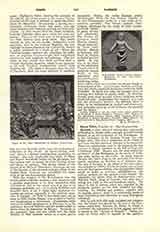

Bassein, a town situated twenty-nine miles north of Bombay in British India, and now of much historic interest as an old settlement of the Portuguese. It is the birthplace of St. Gonsalo Garcia, the only Indian saint, who was a companion of St. Philip de las Casas, the first native of America to be canonized. These two missionaries were in the group of the first martyrs of Japan, crucified on the hill of Nagasaki, February 5, 1597. Bassein was the most important settlement of the Portuguese in the north of India, Goa lying farther to the south. In many respects Bassein was Goa’s rival in the sixteenth and seventeenth centuries, as Bombay is of Calcutta now. The city of Bassein, in the island of the same name, was founded in 1536 by Nunho de Cunha, one of those intrepid Portuguese soldiers who distinguished themselves in India as warriors, administrators, and zealous workers for the spread of the Gospel. He conquered the island from its Mohammedan ruler, Bahadur Shali, King of Gujerat, and soon had a strong fort built in the southwestern corner. The island is rich in timber, which was regarded in the sixteenth century as the best material for ship-building. Its fertility and position, together with its healthy climate, made it a commercial center of some importance, and the home of many Portuguese noblemen.
Side by side with this early conquest and colonization the Gospel was spread by the zeal of the Franciscan missionary, Antonio do Porto, to whom is attributed the conversion of 10,156 pagans, and who is known as the “Apostle of Bassein”. Father Antonio do Porto built at Agasshi in the northern Bassein district, as early as 1535, an orphanage for the education and maintenance of forty boys, all converts from paganism, under the invocation of Nossa Senhora da Luz. This orphanage gave to the Church the first Indian martyrs known to history. In April, 1540, a Mohammedan force from Gujerat approached the orphanage, on the return from a fruitless attack on the Bassein fort. Nearly all the inmates of the orphanage had fled for shelter to the fort, but five of them had remained. These were at first urged to renounce their faith; failing in this, the Mohammedans cruelly tortured them, and locking them in a room set fire to it.
In 1542 the Jesuits came to Bassein. St. Francis Xavier visited the city of Bassein three times, once in 1544, and twice in 1548. During his last visit, in December, 1548, he founded the College of the Holy Name of God. The Jesuits on their advent divided both the missionary and educational work with the Franciscans, the latter laboring among the lower, and the former among the higher, classes. Other religious orders also found their way to Bassein, which became the center of their missionary activity. In the college of the Jesuits in the Bassein fort St. Gonsalo Garcia was brought up from his early youth. He was born about the year 1564. At the age of sixteen he voluntarily accompanied some of the Jesuit fathers of the college, who were ordered to join the mission of Japan. He labored with singular zeal as a catechist for eight years, having acquired the Japanese language marvellously within a short time. During that time he petitioned to join the order, but as his reception was delayed he left the Jesuits on the best of terms and became a merchant. He was blessed with an abundance of riches which he distributed largely among the poor.
Business interests often took Gonsalo to Manila, where he used to visit the Franciscan fathers and assist them as an interpreter in hearing the confessions of some Japanese Christians. On one occasion, when deep in prayer, he was inspired to seek admission into the Franciscan Order. He did so, and became an exemplary lay brother. On May 21, 1593, he was sent back to Japan with a body of Franciscans to aid them in preaching the Gospel. The many conversions made by them caused a persecution which gave to the Church the first martyrs of Japan. They were twenty-six in number and were crucified on a hill at Nagasaki February 5, 1597. They were beatified in 1627, and canonized in 1862.
Bassein was taken from the Portuguese by the Mahrattas in 1739, from the Mahrattas by the English in 1802, and is now a ruined town of much historic interest which no one who goes to Bombay fails to visit. The fort is perhaps the best of the ruined Portuguese fortifications in India. Bassein is a Christian oasis in the midst of the pagan and Mohammedan population of India. It has nine churches, twelve priests, and 16,119 Christians, all Catholics; a Protestant mission was opened in 1904 by the Ritualists but did not flourish and is now practically abandoned.
P. A. FERNANDES

